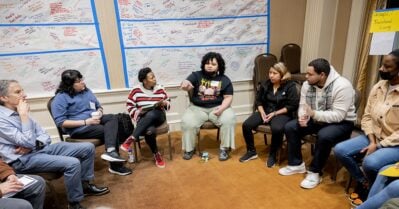Our education and employment investments help youth and young adults prepare for and navigate the labor market, including addressing structural barriers that perpetuate racial disparities. We develop pathways that better integrate school and work while promoting equity in education and employment with partners that include:
- local and state policymakers;
- businesses;
- intermediaries;
- community organizations;
- funders; and
- researchers.
- Creating industry partnerships. This strategy builds upon existing programming and lessons to increase employment and advancement opportunities for youth and young adults, particularly young people of color. Generation Work and related investments engage employer-facing organizations in building diverse talent pipelines.
- Supporting high school and postsecondary success. This strategy seeks to promote approaches that help youth and young adults reconnect and stay connected to education and employment. Investments such as Learn and Earn to Achieve Potential (LEAP) and the Partnership to Advance Youth Apprenticeship (PAYA) advance pathways to high school graduation, including the expansion of reconnection centers and high-quality alternative high school models.
- Preparing for the changing labor market. This strategy helps students and young workers navigate the changing economy. Approaches identified include:
- In 2021, its final year of phase one, Generation Work partners served 12,378 young adults, with 25% completing job training. Of those completers, 69% either enrolled in ongoing education and/or obtained employment. Additionally, partners engaged 1,412 unique employers.
- During the 2021/2022 school year, PAYA grantees partnered with 239 employers to hire 1,634 youth apprentices across 60 pathways to careers.
- As of June 2022, LEAP has enrolled 4,244 young people, with over a third of youth in high school graduation to career pathways attaining a high school diploma or equivalency. Approximately 50% of youth on career pathways enrolled in college, and 40% of youth obtained part-time or full-time employment.
- REDF, an employment social enterprise investor, committed $3 million in capital to 10 employment social enterprises in 2022. All 10 enterprises focus on employing individuals, including young adults, who have barriers to employment. Two of the enterprises are in the South and Southwest, and three focus on the youth and young population.
- The Families and Workers Fund — which promotes investment in high-quality jobs that provide family-sustaining pay, benefits and career progression — has distributed over $5 million in funding to six grantees focused on advancing quality jobs and improving the financial well-being of workers with low wages.
- WorkRise is a research-to-action network aimed at identifying, testing and sharing ideas for transforming the labor market. It has awarded $2.4 million to 22 research grantees to inform and drive action toward strengthening economic security and mobility for workers earning low wages in the U.S. labor market.
- Drawing from the work of local Generation Work partnerships, a 2021 Aspen Institute report explores strategies for engaging with employers around supporting equity and inclusion in the workplace and expanding good-fit jobs in their communities.
- Pathways to High-Quality Jobs for Young Adults, a 2021 report from the Brookings Institute and Child Trends, examines employment outcomes for young people from disadvantaged backgrounds and identifies essential experiences that can increase their chances of landing good jobs later in life.
- Drawing on lessons from Generation Work, a 2018 Aspen Institute report explains how “now jobs” can help young adults address their immediate income needs while also preparing them for long-term career opportunities.
- The University of Massachusetts Amherst’s Center for Employment Equity’s 2022 report, Onboarding Young Workers in a Post-Pandemic World, recommends ways employers can develop workplaces that support and encourage young workers.
- Drawing on lessons learned from LEAP, the Casey Foundation released a 2021 resource that identifies six core elements public systems, service providers and nonprofit organizations can adopt to strengthen supportive educational and career pathways for young people, especially systems-involved and homeless youth.
- Youth participatory research is an equity-centered strategy to promote stakeholder engagement in evidence-building while also promoting positive youth development. Child Trends’ 2021 photovoice study highlights how Generation Work partners are operationalizing core positive youth development principles, such as open communication and mutual respect, and creating opportunities to contribute and belong. MDRC’s participatory evaluation approach helps partners better understand the experiences of young people as they engage in LEAP program services and worked toward their goals.
- PAYA and its national partners have developed multiple resources to support the development of high-quality youth apprenticeship programs. Two 2022 resources include:
- a brief that discusses approaches for incorporating youth apprenticeships perspectives in the design and implementation of programs; and
- a policy playbook that outlines ways state leaders can support the expansion of apprenticeship programs and systems.
- Three briefs from the Center for Economic and Policy Research, released between 2021 and 2022, provide insight into the high unemployment rate experienced by Black youth in the U.S. as well as recommendations for policies that would lead to higher employment rates for Black Americans.
- A 2022 report from Upwardly Global uses survey results and focus group discussions to provide insight into the struggles young immigrants face in the U.S. labor market. It highlights strategies that employers can use to attract and retain diverse young talent.
We work with a number of partners to create, demonstrate and implement effective solutions that connect people to economic opportunity:



